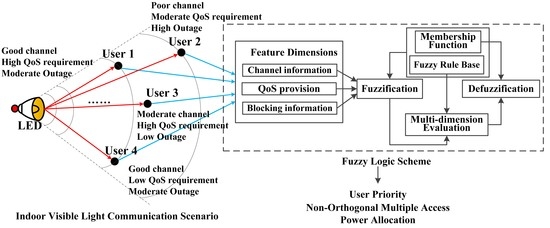Power Allocation of Non-Orthogonal Multiple Access Based on Dynamic User Priority for Indoor QoS-Guaranteed Visible Light Communication Networks
Abstract
:1. Introduction
2. Materials and Methods
2.1. System Model
2.2. Dynamic User Priority
2.3. QoS-Guaranteed NOMA-VLC GRPA
3. Results and Discussion
3.1. Experimental Conditions and Parameters
- To determine the performance difference between static and dynamic user priorities, we performed comparisons among NOMA FL, NOMA PLS and NOMA FTPA.
- To demonstrate the performance difference between NOMA and OMA, we measured NOMA FL and OFDMA FL with the same dynamic user priority.
- Case 1 (analysis of FL dimensions): Without considering QoS requirements, PLS and FTPA can equivalently be regarded as two-dimension considerations of the channel gain and outage. For two dimensions of FL features, we performed experiments regarding the user data rate and user satisfaction in NOMA FL and OFDMA FL without QoS constraints. In this case, we discovered that PLS and FTPA cannot successfully guarantee the QoS, and that the maximization of throughput is not equivalent to the provision of QoS data rate.
- Case 2 (analysis of the variety of QoS): For the three complete FL features, comparing PLS with FTPA, NOMA FL revealed the difference between dynamic and static user priorities. In regard to the comparison of NOMA FL with the dynamic user priority of OFDMA FL, NOMA FL was able to accommodate QoS requirements to show a difference in system performance. In this case, regarding the tradeoff between user data rate and QoS guarantee, we introduced the commonly used evaluation measure of QoS guarantee to demonstrate the clear advantages of FL.
- Case 3 (analysis of VLC lighting): In different visible lighting conditions, we showed the relationship between the FOV angle of illumination and the performance of the communication schemes. In this case, combined with VLC UDN, we considered both high user density and area user traffic demands to show the advantage of FL.
- Evaluation indicators: the average user data rate (AUDR), Jain fairness [27], max-min fairness [5,27] and user satisfaction [25] were introduced. Jain fairness was used to evaluate the impartiality of the user data rate and max-min fairness focused on the guaranteed baseline of the QoS data rate. User satisfaction [21,28] is a comprehensive evaluation indicator that consides both data rate and fairness.
3.2. Case 1: Experimental Analysis in FL dimensions
3.3. Case 2: Experimental Analysis of QoS Guarantee
3.3.1. User Satisfaction
- The tradeoff between the AUDR and QoS guarantee exists in VLC networks. Only AUDR cannot reflect the performance of QoS provision.
- The measurement of AUDR is one-sided, which is not enough to indicate the degree of users’ QoS satisfaction. To discuss the QoS guarantee, user satisfaction should be considered to comprehensively evaluate the performance of FL in QoS provision.
3.3.2. QoS Variety
3.3.3. Fairness
3.4. Case 3: Experimental Analysis of VLC Lighting
4. Conclusions
Author Contributions
Funding
Acknowledgments
Conflicts of Interest
Abbreviations
| AP | Access point |
| AUDR | Average user data rate |
| CDF | Cumulative distribution function |
| FL | Fuzzy logic |
| FOV | Field of vision |
| FTPA | Fractional transmit power allocation |
| GRPA | Gain ratio power allocation |
| ISD | Inter-site distance |
| ITU-R | International telecommunications union-radio |
| LED | Light-emitting diode |
| LiFi | Light fidelity |
| LOS | Line of sight |
| Mbps | Megabits per second |
| MF | Membership function |
| NOMA | Non-orthogonal multiple access |
| OFDMA | Orthogonal frequency division multiple access |
| OMA | Orthogonal multiple access |
| OOK | On-off keying |
| OWC | Optical wireless communication |
| Probability density function | |
| PLS | Power law strategy |
| QoS | Quality of service |
| SIC | Successive interference cancellation |
| SINR | Signal interference plus noise ratio |
| UDN | Ultra dense network |
| VLC | Visible light communication |
| WiFi | Wireless fidelity |
References
- Chen, S.; Qin, F.; Hu, B.; Li, X.; Chen, Z.; Liu, J. User-Centric Ultra-Dense Networks for 5G; Springer: Cham, Switzerland, 2018; pp. 1–3. [Google Scholar]
- Chen, S.; Qin, F.; Hu, B.; Li, X.; Chen, Z. User-centric ultra-dense networks for 5G: Challenges, methodologies, and directions. IEEE Wirel. Commun. 2016, 23, 78–85. [Google Scholar] [CrossRef]
- Haas, H.; Yin, L.; Wang, Y.; Chen, C. What is lifi? J. Lightw. Technol. 2016, 34, 1533–1544. [Google Scholar] [CrossRef]
- Yin, L.; Popoola, W.O.; Wu, X.; Haas, H. Performance evaluation of non-orthogonal multiple access in visible light communication. IEEE Trans. Commun. 2016, 64, 5162–5175. [Google Scholar] [CrossRef]
- Ding, Z.; Dai, H.; Poor, H.V. Relay selection for cooperative NOMA. IEEE Wirel. Commun. Lett. 2016, 5, 416–419. [Google Scholar] [CrossRef]
- Zhang, X.; Gao, Q.; Gong, C.; Xu, Z. User grouping and power allocation for NOMA visible light communication multi-cell networks. IEEE Commun. Lett. 2017, 21, 777–780. [Google Scholar] [CrossRef]
- Marshoud, H.; Kapinas, V.M.; Karagiannidis, G.K.; Muhaidat, S. Non-orthogonal multiple access for visible light communications. IEEE Photonics Technol. Lett. 2016, 28, 51–54. [Google Scholar] [CrossRef]
- Mitra, R.; Bhatia, V. Precoded Chebyshev-NLMS-Based Pre-Distorter for Nonlinear LED Compensation in NOMA-VLC. IEEE Trans. Commun. 2017, 65, 4845–4856. [Google Scholar] [CrossRef] [Green Version]
- Chen, C.; Zhong, W.D.; Yang, H.; Du, P. On the performance of MIMO-NOMA-based visible light communication systems. IEEE Photonics Technol. Lett. 2018, 30, 307–310. [Google Scholar] [CrossRef]
- Jia, K.; Hao, L.; Bai, L.; Yu, C. Indoor Visible Light Communication System Based on Non-Orthogonal Multiple Access. Acta Opt. Sin. 2017, 37, 70–80. [Google Scholar] [CrossRef]
- El-Sayed, M.M.; Ibrahim, A.S.; Khairy, M.M. Power allocation strategies for Non-Orthogonal Multiple Access. In Proceedings of the 2016 International Conference on Selected Topics in Mobile and Wireless (MoWNeT), Cairo, Egypt, 11–13 Apirl 2016; pp. 1–6. [Google Scholar] [CrossRef]
- Hojeij, M.R.; Farah, J.; Nour, C.A.; Douillard, C. Resource allocation in downlink non-orthogonal multiple access (NOMA) for future radio access. In Proceedings of the 2015 IEEE 81st Vehicular Technology Conference (VTC Spring), Glasgow, UK, 11–14 May 2015; pp. 1–6. [Google Scholar] [CrossRef]
- Saito, Y.; Benjebbour, A.; Kishiyama, Y.; Nakamura, T. System-level performance evaluation of downlink non-orthogonal multiple access (NOMA). In Proceedings of the 2013 IEEE 24th International Symposium on Personal Indoor and Mobile Radio Communications (PIMRC), London, UK, 8–11 September 2013; pp. 611–615. [Google Scholar] [CrossRef]
- Benjebbour, A.; Li, A.; Saito, Y.; Kishiyama, Y.; Harada, A.; Nakamura, T. System-level performance of downlink NOMA for future LTE enhancements. In Proceedings of the 2013 IEEE Globecom Workshops (GC Wkshps), Atlanta, GA, USA, 9–13 December 2013; pp. 66–70. [Google Scholar] [CrossRef]
- Hojeij, M.R.; Farah, J.; Nour, C.A.; Douillard, C. New optimal and suboptimal resource allocation techniques for downlink non-orthogonal multiple access. Wirel. Pers. Commun. 2016, 87, 837–867. [Google Scholar] [CrossRef]
- Oviedo, J.A.; Sadjadpour, H.R. A new NOMA approach for fair power allocation. In Proceedings of the 2016 IEEE Conference on Computer Communications Workshops (INFOCOM WKSHPS), San Francisco, CA, USA, 10–14 April 2016; pp. 843–847. [Google Scholar] [CrossRef]
- Cao, Y.; Yang, Z.; Feng, Y. New NOMA power allocation strategy. J. Commun. 2017, 38, 157–165. [Google Scholar] [CrossRef]
- Yapici, Y.; Guvenc, I. Non-Orthogonal Multiple Access for Mobile VLC Networks with Random Receiver Orientation. arXiv, 2018; arXiv:1801.04888. [Google Scholar]
- Sediq, A.B.; Gohary, R.H.; Schoenen, R.; Yanikomeroglu, H. Optimal tradeoff between sum-rate efficiency and Jain’s fairness index in resource allocation. IEEE Trans. Wirel. Commun. 2013, 12, 3496–3509. [Google Scholar] [CrossRef]
- Li, X.; Zhang, R.; Wang, J.; Hanzo, L. Cell-Centric and User-Centric Multi-User Scheduling in Visible Light Communication aided networks. In Proceedings of the IEEE International Conference on Communications (ICC), London, UK, 8–12 June 2015; pp. 5120–5125. [Google Scholar] [CrossRef]
- Wang, Y.; Wu, X.; Haas, H. Fuzzy logic based dynamic handover scheme for indoor Li-Fi and RF hybrid network. In Proceedings of the 2016 IEEE International Conference on Communications (ICC), Kuala Lumpur, Malaysia, 22–27 May 2016; pp. 1–6. [Google Scholar] [CrossRef]
- Jin, F.; Zhang, R.; Hanzo, L. Resource Allocation Under Delay-Guarantee Constraints for Heterogeneous Visible-Light and RF Femtocell. IEEE Trans. Wirel. Commun. 2015, 14, 1020–1034. [Google Scholar] [CrossRef] [Green Version]
- Jin, F.; Li, X.; Zhang, R.; Dong, C.; Hanzo, L. Resource allocation under delay-guarantee constraints for visible-light communication. IEEE Access 2016, 4, 7301–7312. [Google Scholar] [CrossRef]
- Cui, J.; Ding, Z.; Fan, P. A novel power allocation scheme under outage constraints in NOMA systems. IEEE Signal Process. Lett. 2016, 23, 1226–1230. [Google Scholar] [CrossRef]
- Hou, J.; O’Brien, D.C. Vertical handover-decision-making algorithm using fuzzy logic for the integrated Radio-and-OW system. IEEE Trans. Wirel. Commun. 2006, 5, 176–185. [Google Scholar] [CrossRef]
- Bu, R.; Wang, S.; Wang, H. Fuzzy logic vector-based forwarding routing protocol for underwater acoustic sensor networks. Trans. Emerg. Telecommun. Technol. 2018, 29, e352. [Google Scholar] [CrossRef]
- Jain, R.K.; Chiu, D.M.W.; Hawe, W.R. A Quantitative Measure of Fairness and Discrimination; Eastern Research Laboratory, Digital Equipment Corporation: Hudson, MA, USA, 1984; pp. 2–7. [Google Scholar]
- Wu, X.; Safari, M.; Haas, H. Three-state fuzzy logic method on resource allocation for small cell networks. In Proceedings of the 2015 IEEE 26th Annual International Symposium on Personal, Indoor, and Mobile Radio Communications (PIMRC), Hong Kong, China, 30 August–2 September 2015; pp. 1168–1172. [Google Scholar] [CrossRef]
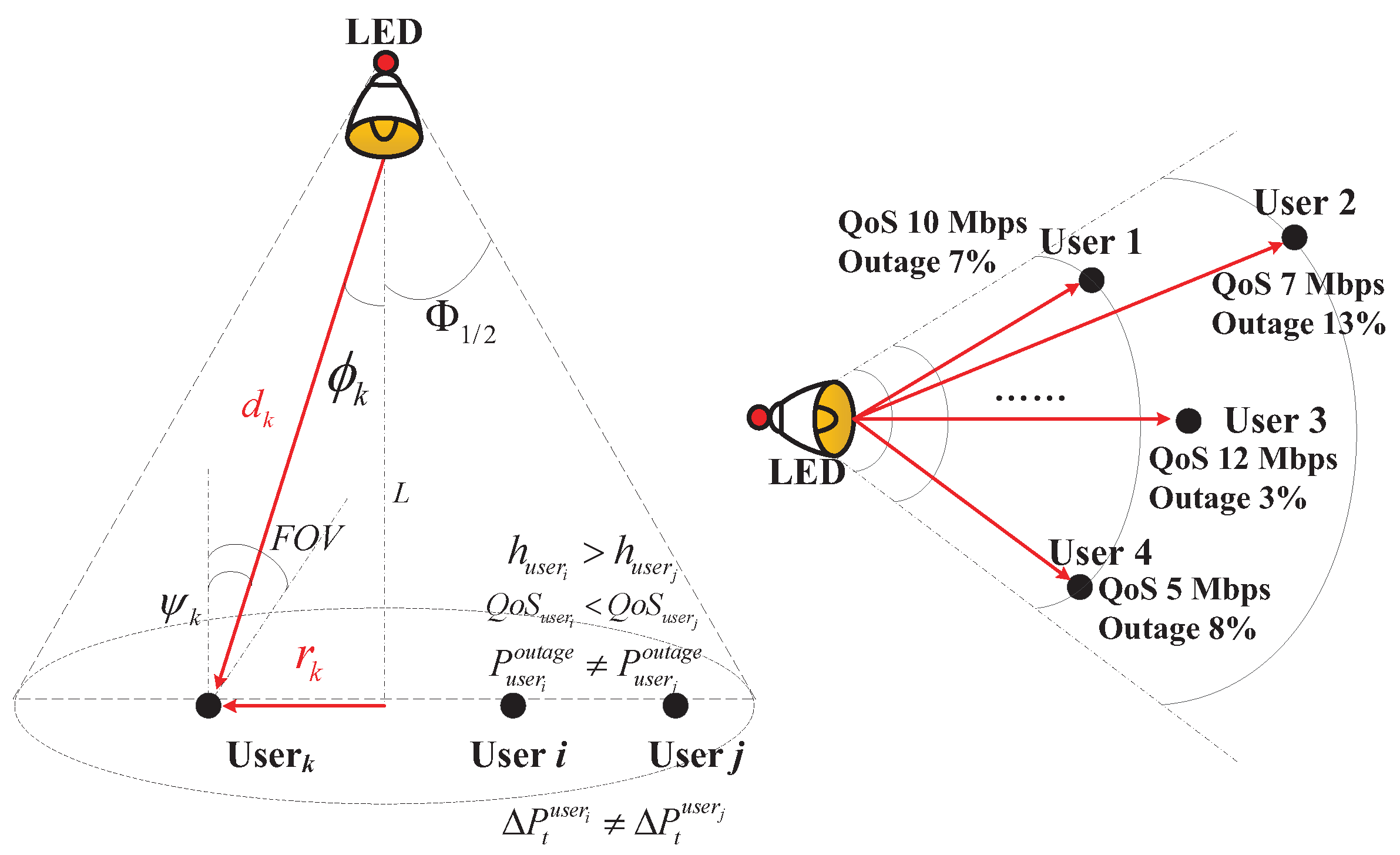
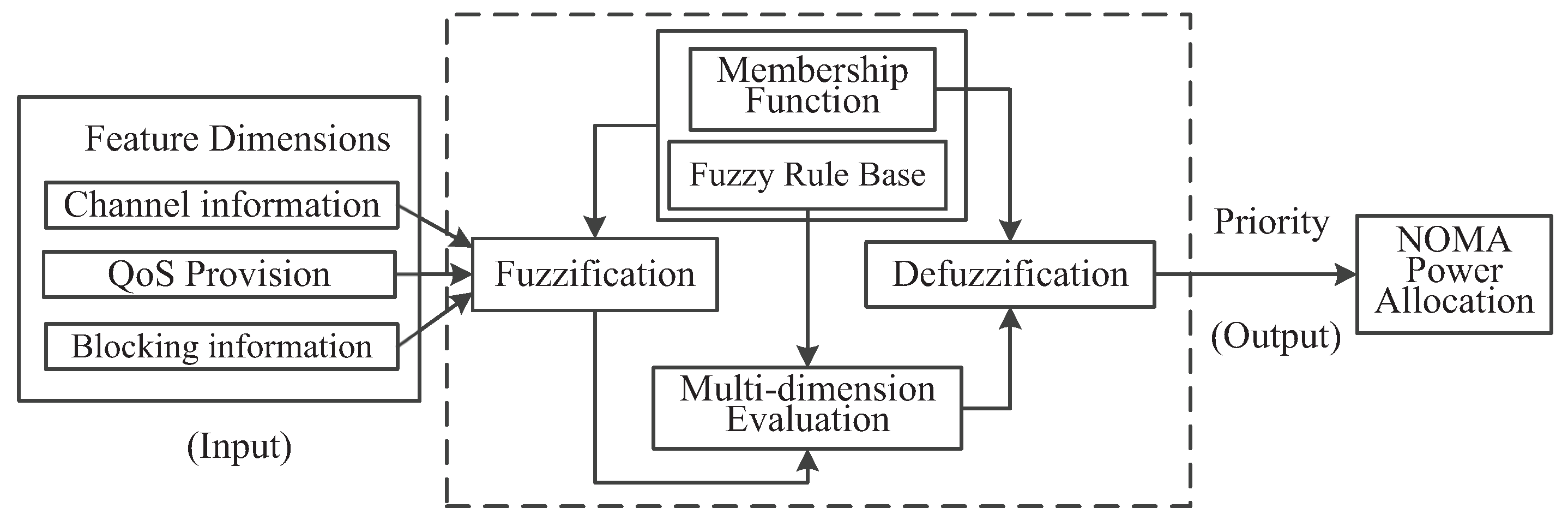
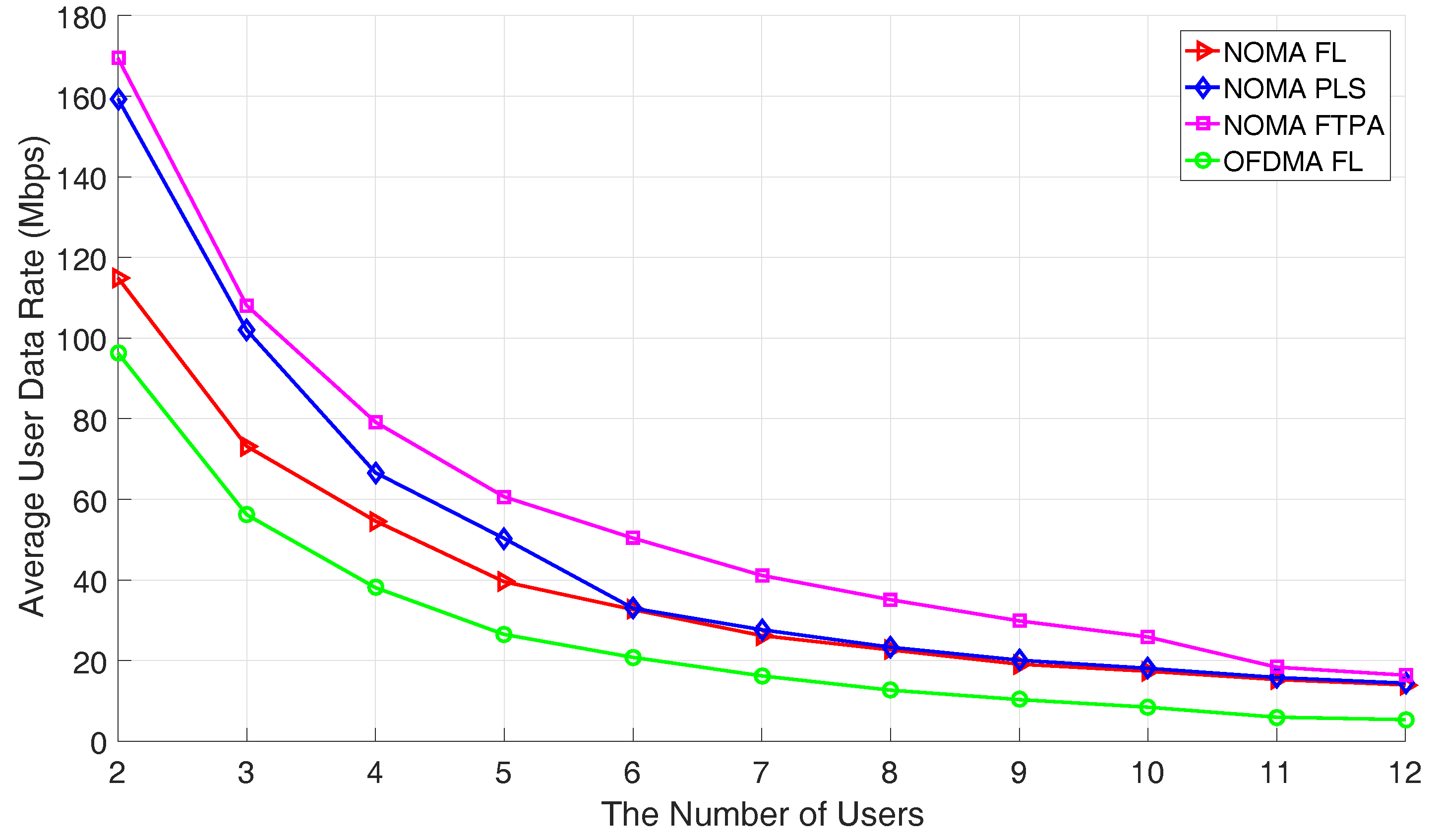





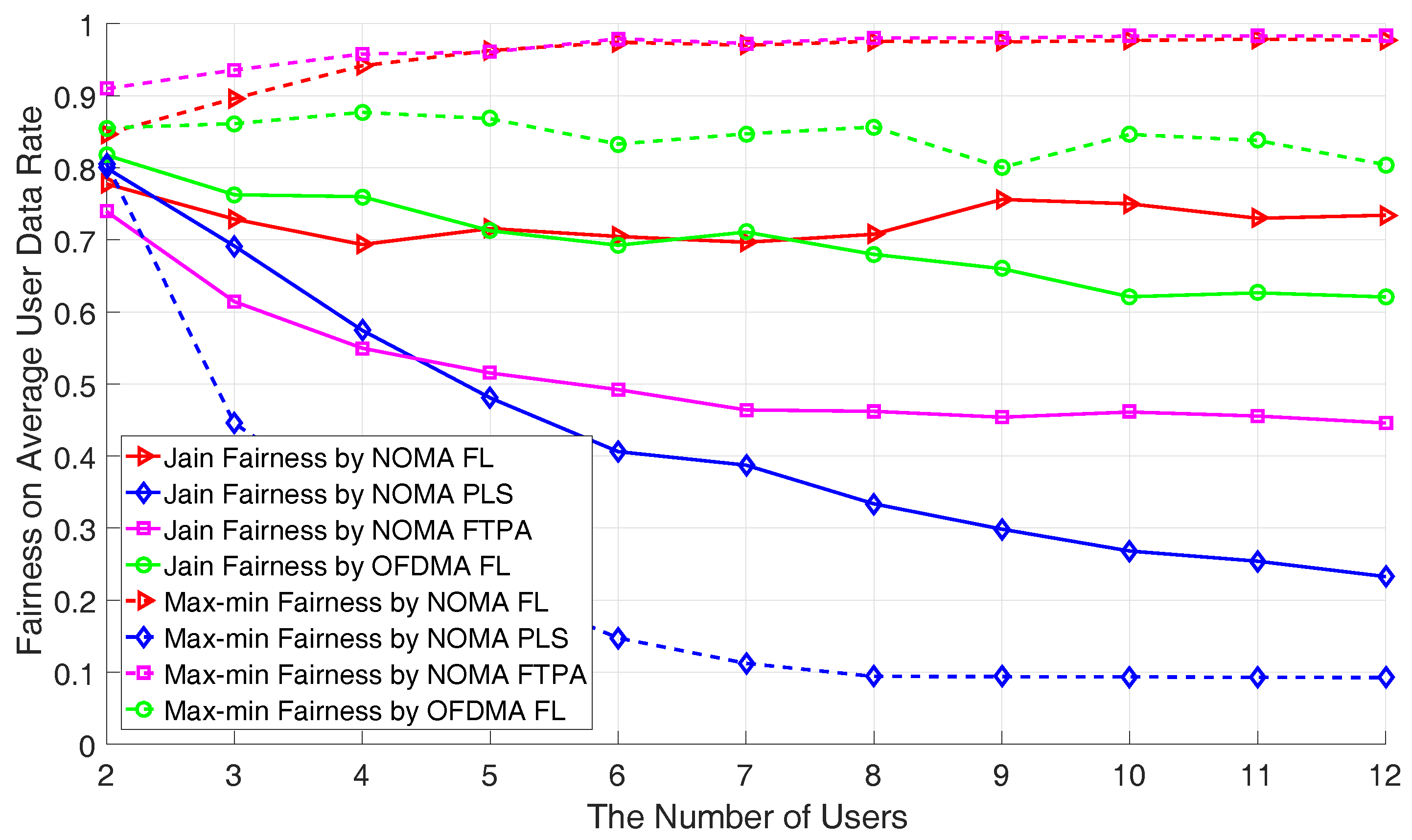
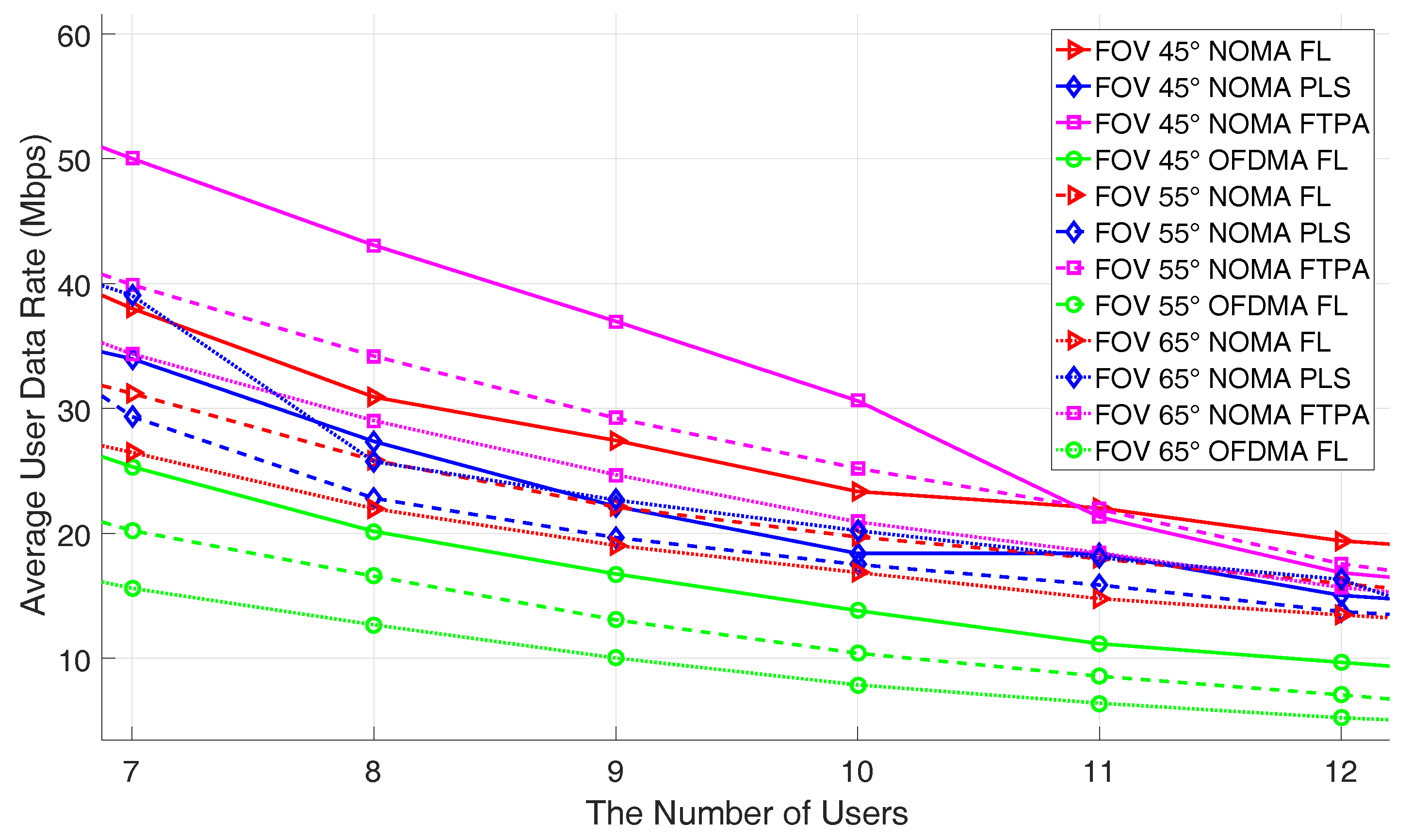
| Input Variables of Three Features | Grades |
|---|---|
| VLC channel gain | (Low, Medium, High) |
| User desired data rate | (Low, Low-Medium, Medium-High, High) |
| NOMA-VLC outage probability | (Low, Medium, High) |
| No. | VLC Channel Gain | Desired Rate | Outage Probability | User Priority |
|---|---|---|---|---|
| 1 | - | High | Low | High |
| 2 | Not Low | Med-High | Low | High |
| 3 | - | High | Not Low | Med |
| 4 | High | Med-High | Not Low | Med |
| 5 | Low | Med-High | Low | Med |
| 6 | - | Low-Med | Low | Med |
| 7 | Not High | Med-High | High | Low |
| 8 | - | Low-Med | High | Low |
| 9 | - | Low | - | Low |
| Symbol | Value | Symbol | Value |
|---|---|---|---|
| Received area | m2 | Received height | m |
| 8 W | 0.47 | ||
| Bandwidth | 25 MHz | /Hz | |
| 1 | n | 1.5 | |
| Description | Case 1 | Case 2 | Case 3 |
|---|---|---|---|
| Influence factor Features | FL dimensions , | QoS, , QoS, | Layout with light angles |
| NOMA FL | Dynamic (, ) | Dynamic (, QoS, ) | |
| NOMA PLS | Static (, ) | Static (, ) | |
| NOMA FTPA | Static (, ) | Static (, ) | |
| OFDMA FL | Dynamic (, ) | Dynamic (, QoS, ) |
© 2018 by the authors. Licensee MDPI, Basel, Switzerland. This article is an open access article distributed under the terms and conditions of the Creative Commons Attribution (CC BY) license (http://creativecommons.org/licenses/by/4.0/).
Share and Cite
Tao, S.; Yu, H.; Li, Q.; Bai, X.; Tang, Y. Power Allocation of Non-Orthogonal Multiple Access Based on Dynamic User Priority for Indoor QoS-Guaranteed Visible Light Communication Networks. Appl. Sci. 2018, 8, 1219. https://doi.org/10.3390/app8081219
Tao S, Yu H, Li Q, Bai X, Tang Y. Power Allocation of Non-Orthogonal Multiple Access Based on Dynamic User Priority for Indoor QoS-Guaranteed Visible Light Communication Networks. Applied Sciences. 2018; 8(8):1219. https://doi.org/10.3390/app8081219
Chicago/Turabian StyleTao, Siyu, Hongyi Yu, Qing Li, Xiangwei Bai, and Yanqun Tang. 2018. "Power Allocation of Non-Orthogonal Multiple Access Based on Dynamic User Priority for Indoor QoS-Guaranteed Visible Light Communication Networks" Applied Sciences 8, no. 8: 1219. https://doi.org/10.3390/app8081219




